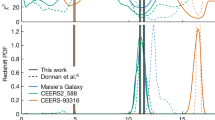Abstract
The majority of known very high-redshift (z>=3.4) quasi-stellar objects (QSOs) have relatively bright apparent magnitudes1,2, R<=18, and recent systematic surveys for fainter high-redshift QSOs3 have failed to find such objects, perhaps implying that the epoch of QSO formation is luminosity dependent. The z=4.01 QSO recently reported4 is quite faint, and was selected by colour rather than spectrum, raising the possibility that previous slitless spectroscopic surveys have been biased against high-redshift QSOs. Here we report the discovery of a faint, red QSO (B>= 21, R ˜ 19) at z = 3.56, selected by 'traditional' low dispersion spectroscopic methods. The surface density of very faint, high-redshift QSOs may not be negligible, with a variety of lines of evidence suggesting that there are at least ˜ 0.2 deg−2 objects with z>= 3.4.
This is a preview of subscription content, access via your institution
Access options
Subscribe to this journal
Receive 51 print issues and online access
$199.00 per year
only $3.90 per issue
Buy this article
- Purchase on Springer Link
- Instant access to full article PDF
Prices may be subject to local taxes which are calculated during checkout
Similar content being viewed by others
References
1. Hazard, C. & McMahon, R. Nature 314, 238–240 (1985). 2. Hazard, C., McMahon, R. G. & Sargent, W. L. W. Nature 322, 38–40 (1986). 3. Schmidt, M., Schneider, D. P. & Gunn, J: E. Astrophys. J. 306,411–427 (1986); 310, 518–533 (1986). 4. Warren, S. J. et al. Nature 325, 131–133 (1987). 5. Osmer, P. Astrophys. J. 253, 28–37 (1982). 6. Anderson, S. F. & Margon, B. Astrophys. J. 314, 111–128 (1987). 7. Koo, D. C. & Kron, R. G. Publs astr. Soc. Pac. 92, 537–545 (1980). 8. Clowes, R. G. Mon. Not. R. astr. Soc. 197, 731–738 (1981). 9. Anderson, S. F. thesis, Univ. Washington, Seattle (1985). 10. Osmer, P. S. Astrophys. J. Suppl. Ser.42, 523–540 (1980). 11. Schmidt, M. & Green, R. F. Astrophys. J. 269, 352–374 (1983). 12. Tananbaum, H. et al. Astrophys. J. 234, L9–L13 (1979). 13. Avni, Y. & Tananbaum, H. Astrophys. J. 262, L17–L21 (1982). 14. Bechtold, J., Weymann, R. J., Lin, Z. & Malkan, M. A. Astrophys. J. 315, 180–197 (1987). 15. Dunlop, J. S. et al. Nature 319, 564–567 (1986). 16. Hoag, A. A. & Smith, M. G. Astrophys. J. 217, 362–381 (1977). 17. Sramek, R. A. & Weedman, D. W. Astrophys. J. 221, 468–480 (1978). 18. Wilkes, B. J. Mon. Not. R. astr. Soc. 218, 331–361 (1986). 19. Trimble, V. & Woltjer, L. Science 234, 155–161 (1986).
Author information
Authors and Affiliations
Rights and permissions
About this article
Cite this article
Anderson, S., Margon, B. Surface density of faint high-redshift quasi-stellar objects. Nature 327, 125–127 (1987). https://doi.org/10.1038/327125a0
Received:
Accepted:
Issue Date:
DOI: https://doi.org/10.1038/327125a0
Comments
By submitting a comment you agree to abide by our Terms and Community Guidelines. If you find something abusive or that does not comply with our terms or guidelines please flag it as inappropriate.



